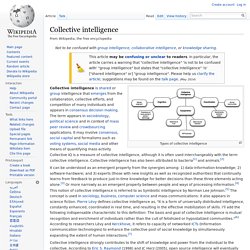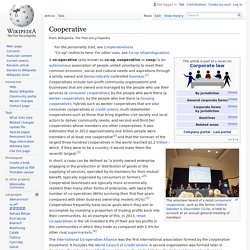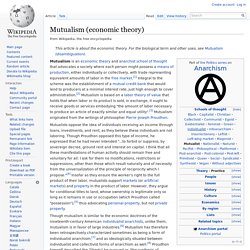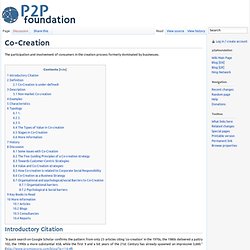

Intentional community. Characteristics[edit] Purpose[edit] The purposes of intentional communities vary in different communities.

They may include sharing resources, creating family-oriented neighborhoods and living ecologically sustainable lifestyles (ecovillages). Many intentional communities focus on the importance of living and sharing life together, as opposed to the perceived trend of independence in Western culture. Types of communities[edit] Some communities are secular; others have a spiritual basis. Some communities provide services to disadvantaged populations, for example, war refugees, the homeless, or people with developmental disabilities. Collective intelligence. Types of collective intelligence Collective intelligence is shared or group intelligence that emerges from the collaboration, collective efforts, and competition of many individuals and appears in consensus decision making.

The term appears in sociobiology, political science and in context of mass peer review and crowdsourcing applications. It may involve consensus, social capital and formalisms such as voting systems, social media and other means of quantifying mass activity. Collective IQ is a measure of collective intelligence, although it is often used interchangeably with the term collective intelligence.
Collective intelligence has also been attributed to bacteria[1] and animals.[2] Cooperative. In short, a coop can be defined as "a jointly owned enterprise engaging in the production or distribution of goods or the supplying of services, operated by its members for their mutual benefit, typically organized by consumers or farmers.

"[4] Cooperative businesses are typically more economically resilient than many other forms of enterprise, with twice the number of co-operatives (80%) surviving their first five years compared with other business ownership models (41%).[5] Cooperatives frequently have social goals which they aim to accomplish by investing a proportion of trading profits back into their communities. As an example of this, in 2013, retail co-operatives in the UK invested 6.9% of their pre-tax profits in the communities in which they trade as compared with 2.4% for other rival supermarkets.[6] The International Co-operative Alliance was the first international association formed by the cooperative movement. It includes the World Council of Credit Unions. Origins[edit] Mutualism (economic theory) Mutualism is an economic theory and anarchist school of thought that advocates a society where each person might possess a means of production, either individually or collectively, with trade representing equivalent amounts of labor in the free market.[1] Integral to the scheme was the establishment of a mutual-credit bank that would lend to producers at a minimal interest rate, just high enough to cover administration.[2] Mutualism is based on a labor theory of value that holds that when labor or its product is sold, in exchange, it ought to receive goods or services embodying "the amount of labor necessary to produce an article of exactly similar and equal utility".[3] Mutualism originated from the writings of philosopher Pierre-Joseph Proudhon.

Mutualists have distinguished mutualism from state socialism, and do not advocate state control over the means of production. Mutualism, as a term, has seen a variety of related uses. For historian of the First International G. M. Mutual organization. Profits made will usually be re-invested in the mutual for the benefit of the members, although some profit may also be necessary in the case of mutuals for internal financing to sustain or grow the organization, and to make sure it remains safe and secure. Background[edit] Community building. Community building is a field of practices directed toward the creation or enhancement of community among individuals within a regional area (such as a neighborhood) or with a common interest.
It is sometimes encompassed under the field of community development. A wide variety of practices can be utilized for community building, ranging from simple events like potlucks and small book clubs, to larger–scale efforts such as mass festivals and building construction projects that involve local participants rather than outside contractors. Co-Creation.
The participation and involvement of consumers in the creation process formerly dominated by businesses.

"A quick search on Google Scholar confirms the pattern: from only 23 articles citing ‘co-creation’ in the 1970s, the 1980s delivered a paltry 102, the 1990s a more substantial 658, while the first 9 and a bit years of the 21st Century has already spawned an impressive 3,660. " ( "Co-creation is a very broad term with a broad range of applications. We define co-creation as any act of collective creativity that is experienced jointly by two or more people. From the Wikipedia: "Co-creation is the practice of developing systems, products, or services through the collaborative execution of developers and stakeholders, companies and customers, or managers and employees. Co-Creation is under-defined! "The literature review itself threw up two related observations: 1. 2. Non-market Co-creation Chris Lawer: Loncin Co-Creation Companies 1. Co-creation. Co-creation is a form of marketing strategy or business strategy that emphasizes the generation and ongoing realization of mutual firm-customer value.

It views markets as forums for firms and active customers to share, combine and renew each other's resources and capabilities to create value through new forms of interaction, service and learning mechanisms. It differs from the traditional active firm – passive consumer market construct of the past. Co-created value arises in the form of personalised, unique experiences for the customer (value-in-use) and ongoing revenue, learning and enhanced market performance drivers for the firm (loyalty, relationships, customer word of mouth).
Scholars C.K.